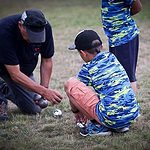Imagine yourself standing under the warm sun, a gentle breeze carrying the sound of laughter and friendly competition. You pick up a cornhole bag, feeling its weight in your hand, ready to take aim.
But do you have the skills and knowledge to truly excel at this classic game? Discover the secrets to mastering cornhole, from perfecting your toss to strategizing your way to victory.
Stay tuned to uncover the ultimate guide that will elevate your cornhole game to the next level.
Key Takeaways
- Understand the rules and scoring system for fair play.
- Set up the cornhole court correctly for an enjoyable game.
- Practice various throwing techniques and strategies for accuracy.
- Enhance gameplay with quality boards, accessories, and personalization options.
Cornhole Basics
To learn the basics of cornhole, one must familiarize oneself with the essential rules and techniques of this popular outdoor game. Cornhole is a game where players take turns throwing bean bags at raised platforms with a hole in it. The goal is to score points by landing bags on the platform or in the hole to be the first to reach 21 points. Cornhole is a versatile game suitable for players of all ages and fitness levels, making it perfect for family gatherings or friendly competitions. The American Cornhole Association, established in 2002, standardized the rules for the game to ensure fair play.
Each player or team typically has four bean bags of one color to throw during their turn. The scoring in cornhole is straightforward: a bag on the platform scores one point, while a bag in the hole scores three points. The game continues until one player or team reaches or exceeds 21 points, and the first to reach this score wins the game. Understanding these basic rules and scoring techniques will set you on the path to becoming a skilled cornhole player.
Setting Up the Game
As you prepare to set up a game of cornhole, positioning two regulation-size boards 27 feet apart is crucial for official gameplay. To ensure a smooth start to your cornhole match, follow these steps:
- Place the Boards: Set up your Regulation Cornhole Boards on a flat surface, making sure they're exactly 27 feet apart from front edge to front edge to adhere to the Official ACA regulations.
- Determine Court Length: Check that the court length falls between 40-45 feet to maintain the proper distance between players, allowing for fair gameplay.
- Distribute Bean Bags: Each player should have a set of four bean bags to pitch during their turn, ensuring that everyone has an equal opportunity to score points.
- Stand in the Pitchers Box: To keep the game moving, players must stand within the pitchers box when throwing their bean bags and adhere to the 20-second time limit for each turn.
Mastering Your Throw
How can you ensure a consistent and accurate throw in cornhole? Mastering your throw involves various elements such as your stance, grip, release, follow-through, throwing techniques, practice, muscle memory, and environmental factors. To enhance your cornhole skills, it's crucial to find a comfortable stance and grip that allows for a smooth and controlled throw. Experiment with different throwing techniques, like backspin or sidearm throws, to determine what works best for you in terms of accuracy and distance. Consistent practice is key to developing muscle memory and improving your throwing skills over time.
Consider the table below to summarize key points for mastering your cornhole throw:
| Aspect | Description |
|---|---|
| Stance | Find a comfortable and balanced position. |
| Grip | Hold the bag firmly but not too tight. |
| Release | Ensure a smooth and consistent release of the bag. |
| Follow-through | Complete your throw with a controlled follow-through. |
Remember to adjust your throw based on environmental factors and board conditions to maintain precision in various playing situations. By focusing on these aspects, you can hone your cornhole skills and become a more accurate player.
Official Rules Overview
Mastering your throw in cornhole sets the foundation for understanding the official rules overview of the game. To play cornhole effectively, grasp the following key points:
- Teams: Cornhole is typically played with two teams, each consisting of two players. This setup fosters competitive play and strategic decision-making.
- Scoring System: Points are earned in cornhole by tossing bean bags onto a raised platform. Landing a bag in the hole scores your team 3 points, while bags that stay on the platform earn 1 point each. Understanding the scoring system is crucial for tactical gameplay.
- 21 Points**: The primary objective in cornhole is to be the first team to reach 21 points. This target score adds an element of excitement and suspense to the game.
- Equipment**: Proper equipment, including regulation cornhole boards and bean bags, is essential for maintaining fairness and enjoyment during gameplay. Ensuring that the equipment meets official rules standards enhances the overall cornhole experience.
Tips for Beginners
To enhance your performance in cornhole as a beginner, focus on refining your grip and stance for improved throwing accuracy. First, ensure your grip is comfortable yet firm on the cornhole bag. Next, position your feet shoulder-width apart with your dominant foot slightly ahead for better balance. Experiment with different throwing techniques like the slide shot or flop shot to find what suits you best. Consistency is key; practice regularly to develop muscle memory and improve your overall gameplay.
Here are some essential tips and tricks for beginners in cornhole:
| Tips and Tricks | Description |
|---|---|
| Aim for the Center | Target the hole's center for higher scoring chances. |
| Practice Throwing | Regular practice will help you refine your skills and improve accuracy. |
| Enjoy the Learning | Have fun while mastering this simple outdoor game filled with dried corn kernels. |
| Learn the Scoring | Understand the official cornhole rules to know how points are scored and how to play with a partner. |
Following these guidelines will set you on the right path to becoming a proficient cornhole player.
Advanced Techniques
To elevate your cornhole game to the next level, focus on mastering advanced techniques that involve precise bag placement and strategic gameplay. Here are four key advanced techniques to enhance your skills:
- Airmail Shot: Master the airmail shot by throwing the bag directly into the hole without it touching the board. This technique requires precision and accuracy to score points effectively.
- Push Shot: Practice the push shot method, where you slide the bag up the board and into the hole. This technique is crucial for strategic plays and can help you secure points while controlling the game.
- Flop Shot: Perfect the flop shot strategy by aiming to land the bag softly on the board and having it slide into the hole. The flop shot is useful for overcoming obstacles on the board and scoring points with finesse.
- Blockers: Learn the strategic use of blockers to obstruct your opponent's path to the hole. Placing blockers strategically can disrupt your opponent's game plan and give you an advantage in scoring.
Experiment with different grips, spins, and angles to improve your accuracy and control in cornhole.
Building Your Boards
When constructing your cornhole boards, ensure that the dimensions adhere to regulation standards for official gameplay. Regulation size boards measure 48' x 24' with a 6' hole in the center, typically made from wood to meet official standards.
It's essential to create a smooth and level surface on the boards to guarantee consistent play. Building your boards not only ensures they meet regulation size but also allows for customization in terms of design, color, and personal touches.
Consider adding unique elements to make your boards stand out while still adhering to the standard requirements. Proper construction is key to the overall quality and enjoyment of the cornhole game, so pay attention to detail when building your boards.
Essential Supplies
Ensure you have the necessary supplies, including two regulation-sized boards and four cornhole bags for each player, to enjoy a fair and fun game of cornhole.
- Two Regulation-Sized Boards: You'll need two cornhole boards that measure 48' x 24'. These boards should be sturdy, smooth, and of regulation size to ensure a standard playing experience.
- Four Cornhole Bags per Player: Each player or team should have four regulation-sized cornhole bags. These bags are typically filled with dried corn kernels or other suitable materials and measure 6' x 6'.
- Playing Cornhole: The game is played with two teams, with one player or team standing at each board. The objective is to score points by landing your cornhole bags on the board or, ideally, through the hole.
- Scoring: When Player A tosses a bag through the hole, they score three points; if the bag lands on the board, they score one point. If Player B scores, the points cancel each other out.
Exciting Accessories
Exciting accessories for cornhole enthusiasts can elevate your game experience and add a touch of personalization to your setup. LED lights are a popular choice, illuminating boards for evening play, extending the fun into the night.
Custom carrying cases offer protection for your boards and bags, making transportation and storage a breeze. Personalized designs and logos on the boards add a unique flair to your cornhole set, reflecting your style and personality.
Scoreboards and drink holders can enhance the playing experience, keeping track of scores and holding beverages conveniently. To further customize your setup, consider accessories like cup holders, score towers, and themed decals.
These additions not only make your game more enjoyable but also allow you to create a cornhole court tailored to your preferences, ensuring every bag touches the ground with a sense of style.
Game Variations
Game variations in cornhole offer diverse ways to enjoy the classic tossing game, each introducing unique rules and challenges.
- Skins Cornhole: This variation assigns a different point value to each round, adding an element of unpredictability and excitement to the game.
- Cancel Scoring Cornhole: In this version, bags cancel each other out, simplifying the scoring process and requiring players to strategize carefully with each throw.
- Cornhole Golf: Players aim to reach specific numbered holes on the board, requiring precision and skill to navigate through the course efficiently.
- Cornhole Baseball: Following baseball rules, bags represent hits and runs, making each toss crucial as players advance around the bases.
These variations not only introduce different scoring systems and board layouts but also encourage strategic play styles as players adapt to the specific rules of each game. Whether focusing on point values, canceling out opponents' scores, navigating a golf course setup, or emulating a baseball game, these variations keep the cornhole experience fresh and engaging for players of all skill levels.





